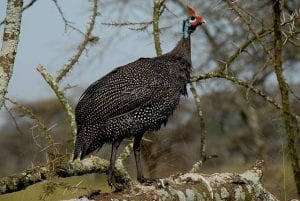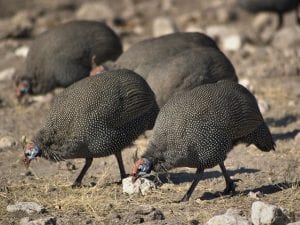Specimen of the Week 271: Helmeted guineafowl
By Dean W Veall, on 23 December 2016
Dean Veall here. ‘Twas the night before the night before Christmas and all the Museum, not a creature was stirring (on account of them being dead and all), not even a mouse, (because that particular specimen was preserved using an experimental freeze drying technique). Festive greetings blog readers. I’ve chosen the guineafowl for my specimen this week, which has (sort of, ish) festive connections. The wild turkey (Meleagris gallopavo), was often confused with the more familiar guineafowl in the 1600’s when European settlers reached America, due to the the featherless heads and similar colouration of the plumage. And with that tenuous festive link, this week’s Specimen of the Week is:
**The helmeted guineafowl **
The helmeted guineafowl (Numida melegaris) is one of the nine species of guineafowl that make up the family of birds Numididae, which are endemic to the African continent. Now widely introduced across the world, the native range of all nine of the recognised sub-species of helmeted guineafowl are found distributed in sub-Saharan Africa. Like other guineafowl, this species has a featherless head, the helmet referred to in the name comes from the dull yellow-reddish knobby protrusion from their bright blue and red crown, which is larger in males than females. These fowl are extremely social and can live in flocks up to 25 strong with mates pairing for life.
Greek Tragedy
The species name of the helmeted guineafowl, meleagris, comes from a story in Greek mythology. Meleager, prince of Macedon, was killed by his mother after murdering his uncles. Meleager’s sisters, weeping in grief, are turned into guinea-hens and their tears form the pearl-shaped markings found on the bird’s feathers.
Eating them
Right, I’m going to get straight down to it and avoid the niceties of the natural history of this species that is normally the way for our Specimen of the Week blogs. It’s Christmas and we are right slap bang in the middle of guineafowl season and many readers may well be partaking of a guineafowl for their festive lunches. Guineafowl have a long history of domestication and it’s thought that history mainly involves this species of guineafowl, Numida melegaris. It’s thought to have been part of the diet of the Egyptians. It wasn’t until the 1500’s that Europeans encountered guineafowl when the Portuguese began importing the birds from their colony in Guinea, eventually becoming commonplace here in the UK in Elizabethan times. I myself have not tasted guineafowl but I have it on good authority that it is more flavourful than chicken.
Merch
In my research for this blog I came across possibly my favourite fowl based international community (sorry Wildfowl and Wetland Trust), unsurprisingly named Guineafowl International. They rank as my favourite purely because they have an official line of merch, some snazzy baseball jersey, cute little baby hat, pin badges and homely throw pillow. If only I’d had sent this out sooner, you could have more time to get the guineafowl mad person in your life a guineafowl related present. Oh well, always next year.
Dean Veall is Learning and Access Officer at the Grant Museum of Zoology
One Response to “Specimen of the Week 271: Helmeted guineafowl”
- 1
 Close
Close






So what’s holding up the head nobble on the live one if it isn’t a bone? Or is the nobble bone missing?